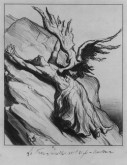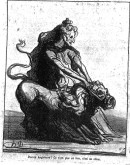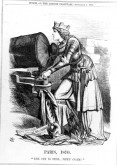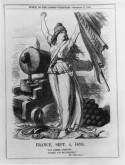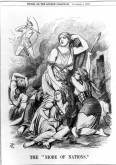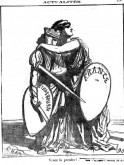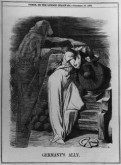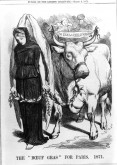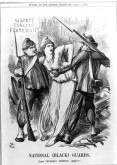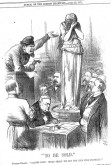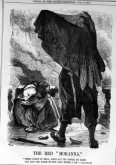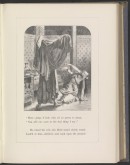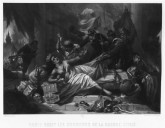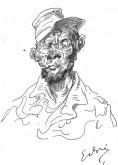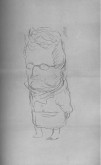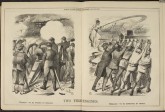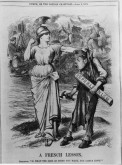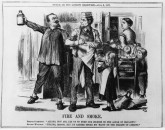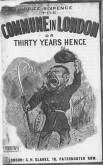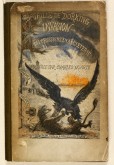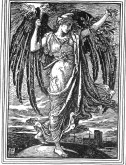The browser will either open the file, download it, or display a dialog.
On February 13, 1871, Le Charivari featured a powerful lithograph by Daumier (1808–79), France-Prometheus and the Eagle-Vulture, of which I reproduce the artist’s proof (fig. 1).[1] Here, Daumier’s characteristic mirth is abandoned for confessional angst. In its unbridled torment, this female Prometheus (La France) recalls the startlingly indecorous wooden crucifix (1849) in the Parisian church of Saint-Gervais-Saint-Protais, by Daumier’s long-time friend Auguste Préault (1809–79; fig. 2). The expressive excess of Préault’s Romantic Christ, with its pectoral strain and vulnerable throat, is echoed in the breast-flattening stretch of Daumier’s heroine and the beaked penetration of her bowels. The cruel tormentor is kin to the emblematic eagle shared by Napoleon III and Prussia. For Daumier, these twin perpetrators of national agony deserved an accusation of high emotional pitch. That agony was but part of what France would suffer during what Victor Hugo called l’Année terrible. Opening with the emperor’s calamitous declaration of war on Prussia and the subsequent loss of Alsace and part of Lorraine to the new German empire (inaugurated at vanquished Versailles), 1870–71 saw the brutal suppression of the Paris Commune, with some twelve to fifteen thousand summary executions.[2]
Across the English Channel, these events were followed with concern. In full-page caricatures for the weekly satirical journal Punch, John Tenniel (1820–1914) tirelessly commented on French affairs. Yet, in the substantial scholarship on this prolific Victorian illustrator—knighted in 1893—there is lean coverage of his plates devoted to l’Année terrible.[3] Indeed, British imagery responding to that terrible year has received little comment since 1872, when Edmond Duranty published an article on international caricature generated by the Franco-Prussian War.[4]
What follows is an account of John Tenniel’s response in Punch to events in France in 1870–71. Tenniel—whose posture changed from sympathy for vanquished France to horror vis-à-vis the Commune—provides a case study of Victorian opinion of France in one of its darkest years.[5] To the art-historical literature on the Commune and the Siege of Paris, I introduce a cross-Channel perspective, bringing salience to affinities between Tenniel’s outlook and opinion in France.[6] At the same time, I distinguish between French imagery—produced with a personal stake in the conflict—and the caricatures of Tenniel, who observed from a vantage of geographic and emotional distance. As the imagery in question is largely allegorical, this inquiry offers an opportunity to take stock of the condition of this high mode of expression in a period in which topical didacticism trumped aspiration toward the ideal.
Daumier’s France- Prometheus accuses not only Napoleon III and Prussia; its rage also is focused across the Channel. The print has been convincingly associated with a passage from the poem “L’Expiation” in Les Châtiments (1853), in which Victor Hugo lamented the defeat of Napoleon I—the collection vilifies Napoleon III—and anathematized England. Hugo sets forth an image of the Promethean Napoleon I nailed to a peak by Destiny, whose mocking laughter spurs on “the Vulture England” to “ronger le Coeur” (gnaw the heart) of the captive.[7] Similarly, in the epic poem Napoléon (1834–36), the ardent nationalist Edgar Quinet had represented the exiled emperor as a “new Prometheus” surrendered to the vulture of Albion.[8]
Infuriated by the neutrality officially adopted by Britain during the Franco-Prussian War, Daumier portrayed the queen as a bony villainess in Pauvre Angleterre! where, reined and muzzled, the once-fierce lion of Britannia is transformed into a frightened dog (fig. 3). Daumier’s resentment toward England was shared by Victor Hugo, who, in the poem “À la France,” from the collection L’Année terrible (1872), accused Victoria’s prime minister of siding with the enemy: “This one, named Gladstone, says to your executioners: thank you!”[9]
Behind the official façade of foreign policy, Victoria was hardly neutral. Given the queen’s German relations, it comes as no surprise that she did not share the sympathy toward France expressed by some of her subjects. Writing to her daughter, the crown princess of Prussia, on September 17, 1870—one day before Paris was besieged—the queen gave vent to counsel kept strictly private:
All was after all not so entirely unexpected in France!! The system of corruption, immorality and gaspillage was dreadful. . . . Your elder brothers unfortunately were carried away by that horrid Paris (beautiful though you may think it) and that frivolous and immoral court did frightful harm to English society. . . . The fearful extravagance and luxury, the utter want of seriousness and principle in everything—the many crimes in France all show a rottenness which was sure to crumble and fall, but certainly not so soon or so suddenly when it did come.[10]
That France’s disaster was the inevitable result of inner rot was versified by a Punch humorist, who, in the November 12, 1870 issue, ridiculed French laments of betrayal. “Nous sommes trahis!” (“We are betrayed!”) lays blame on all aspects of French political and social life. Following stanzas that list the shortcomings of, respectively, the defeated nation’s emperor, ministers, publicists, orators, journalists, officers, and troops, its people are accused of “Striving and shouting, ‘Vive this!’ and ‘Vive that!’ / While she, whose life you live, France, bleeds to death: / and while fierce factions on her blood wax fat.”
Such middle brow chauvinism was standard in Punch; its Francophobia chronically flared with each violent vicissitude in French politics.[11] At the same time, the defeat engendered warmer feelings conveyed by the journal’s chief caricaturist. During forty years, Tenniel drew over 2,000 full-page Punch caricatures, whose subjects were decided at weekly Wednesday Punch dinners.[12] This was an artist of French ancestry, raised, like his father, in the Huguenot neighborhood of Marylebone. A stirring of ancestral feeling is suggested by the September 3, 1870 issue (fig. 4), in which Tenniel represented the bold spirit of the French capital in the twilight of the Second Empire.[13] Paris adopts a martial air worthy of Joan of Arc, who would be frequently represented in France to offer her descendants solace and hope in the wake of the defeat by Prussia. Her severe profile vigilantly directed along the cannon barrel, Paris stands on discarded trappings of her recent, festive past—a fool’s cap and papers referring to entertainment and social events. This representation of Paris sobered by war, and, consequently worthy of British respect hardly prepares us for Tenniel’s France, Sept. 4, 1870 (fig. 5). Commemorating the date on which Paris—having received news of the Prussian victory at Sedan and the capture of Napoleon III—proclaimed the Republic, and initiated its Government of National Defense, Tenniel captioned the plate with a passage from the Marseillaise. A fierce Marianne raises the sinewy arms of a worker while trampling emblems of the fallen empire. While celebration of the Emperor’s downfall is to be expected of Punch, it is unusual, to say the least, for a Victorian Tory to represent militant French Republicanism with such dignity.[14]
With less restraint, the Francophile Algernon Charles Swinburne wrote an “Ode on the Proclamation of the French Republic” dedicated to his idol, Victor Hugo:
Who is this that rises red with wounds and splendid,
All her breast and brow made beautiful with scars,
Burning bare as naked daylight, undefended,
In her hands for spoils her splintered prison-bars,
In her eyes the light and fire of long pain ended,
In her lips a song as of the morning stars?[15]
This unbridled hymn to the glory of the resurrected Republic was, predictably, satirized by an anonymous detractor:
Hide with your noise pale women’s lamentations,
Hide sobs and tears ‘neath pyrotechnic showers;
Mouth out your fill with all exaggerations;
Mock and insult the pallid queen who cowers;
Take up the curse fought for through generations,
Won by the prostitution of your powers.[16]
Swinburne’s verse—“pyrotechnic showers,” in the words of the satirist—contrast with Tenniel’s flat-footed allegories. The latter have a literal directness that brings to mind Hippolyte Taine’s observation that the caricatures in Punch are “as hard and exact as if drawn by John Bull himself.”[17] Resembling the armored, chivalric heroes of Tenniel’s popular illustrations of 1861 for Thomas Moore’s romance Lallah Rookh (1817), the Punch allegories have the aspect of dutifully acted costume pieces. The blunt tenor of Tenniel’s plates reflects the principal criteria against which the subjects were chosen: that they be clearly legible and unambiguous in meaning. Daumier’s France-Prometheus offers a telling contrast (cf., fig. 1). Whereas Tenniel relies on schematic narrative, the power of Daumier’s lithograph arises from formal invention, as in the vigorous graphic language of the predator’s ragged, flaming wings, which ominously mimic the victim’s spread arms.
The problem of translating allegory into foursquare, plain English becomes more evident when Tenniel responds, with awkward sentimentality, to the increasingly bleak outlook for France in The Niobe of Nations, in the November 5 issue (fig. 6). Tormented by an unlikely Apollo—the kaiser in tunic and spiked helmet—France falters amid an expiring brood that includes, at the right, a furious Paris which, on October 31, had erupted in attempted insurrection as news broke of Metz’s fall. Tenniel personifies France as Niobe—the unfortunate mother punished by the gods for hubris. The verse accompaniment to the caricature asks, “Lo, who is ‘Niobe of Nations’ now!” The answer is hardly complimentary: “She that was thought so strong and was so proud, / Whose armed and sceptered head and haughty brow / Once o’erawed Europe, at her footstool bowed.” Even the Francophile George Meredith struck a patronizing note in the poem “France, December 1870.” The stricken nation (“O Mother of a fated fleeting host”), according to the poet, had reaped what it had sown:
Conceived in the past days of sin, and born
Heirs of disease and arrogance and scorn,
. . . . . . . . . . . . . . . . . . . . . . . . . . . . . . . .
Do thou stoop to these graves here scattered wide
Along thy fields, as sunless billows roll;
These ashes have the lesson for the soul.[18]
Against the moralizing sympathies of Tenniel and Meredith can be set the maternal embrace of vanquished Strasbourg by armed France, defiantly taunting the enemy, “Come and get her!” (fig. 7). This sober caricature is by Cham (Count Amédée-Charles-Henri de Noé, 1819–79), better known for wittily skewering paintings exhibited at the Salon. Foreshadowing the national martyrdom that became a staple of French public art in the early Third Republic,[19] Cham’s lithograph is a call to action rather than—as in The Niobe of Nations—an expression of pity.
As Prussian artillery encircled Paris and the obstinate, bombarded capital, refusing to endorse the national surrender, starved, Tenniel’s pity assumed a genuinely tragic bearing. Germany’s Ally (fig. 8) in the December 10, 1870 issue of Punch features a despairing Paris, her Phrygian cap gone and a broken, foodless plate at her feet. Desperation has left no place for the trite facial expression and stilted staging that characteristically sentimentalize Tenniel’s allegorical caricatures for Punch. Instructive labeling is upstaged by a chilling chiaroscuro, wherein the wraith—its boneless reach enhanced by the sky’s dark, horizontal grain—shadows the victim. This exception to the characteristic banality of Tenniel’s commentary on French affairs was among the images admired by Edmond Duranty: “It is strange to recognize our own heart beating so strongly in an English breast, and our own sorrow, borne by the English with unequaled vigor.”[20] The image stands as a rare vindication of Tenniel’s ambition as an allegorist. This aspiration went back as far as his high-minded The Spirit of Justice, a winner in the 1845 cartoon competition for the decoration of Westminster Palace. While he did not, in the end, paint The Spirit of Justice, he did execute for the palace the tepid A Song for St. Cecilia’s Day (1850), earnestly travelling to Munich beforehand to study fresco technique. Notwithstanding the lofty aspiration to bring to London a continental-grade, government-sponsored decorative cycle, the result was lackluster.[21]
In early March, shortly after the Prussians entered Paris and the National Assembly signed away Alsace and part of Lorraine, Tenniel sent condolences across the Channel in The “Boeuf Gras” for Paris. 1871 (fig. 9). Referring to the Parisian tradition in which the city’s butchers paraded a fat ox at the close of Carnival, Tenniel shows a mournful Peace leading a bovine emissary of England’s good will. Just as the ox brings abundance in its wake, so, too, did concerned Britons, acting independently of their neutral government, assist wartime France. Richard Wallace and Lord Hertford, for example, organized and financed medical assistance, and the actress and courtesan Cora Pearl converted her home into a hospital. Such gestures vouch for what the art critic Jules Claretie said of the stricken city’s appeal, “In festive times, Paris can be stunning; Paris in mourning is irresistible”[22]
Tenniel’s good will ended abruptly with the proclamation of the Paris Commune on March 28, 1871.[23] Henceforth, his Punch imagery reminds us of the artist’s conservatism, and that his Huguenot forebears had crossed the Channel to seek refuge from persecution. The melodramatic National (Black) Guards, published in the April 1, 1871 issue, decried the plight of Paris in the clutches of the Commune (fig. 10). Seized by two ruffian National Guardsmen—one wearing a grubby Phrygian cap—Paris cries out “MURDER! THIEVES! HELP!!” The plate is accompanied by a hyperbolic poem titled “In the Hands of the Sansculottes” [sic]. Here, the Commune is characterized as a bloodthirsty return to the Reign of Terror: “Beneath the canopy of lurid smoke, / Brooding above the blood that stains her stones, / Pale phantoms of old terror, new awoke, / The Furies of red Ninety-three invoke.” With unmistakable animus toward Paris, the author blames the victim: “Has she passed thorough the famine, and the flame, / By her endurance half redeemed her name / From its foul taint of wantonness and sin, / To sink to this extremity of shame!” In “To Be Sold” of April 22 (fig. 11), Tenniel spreads accusation across the political spectrum. France—an allegorical cousin to Victorian representations of fallen women—stands in the degradation of slavery. While a Communard auctioneer, using a pistol as a gavel, asks, “Allons donc! What shall we say for this fine property?” accounts are kept by a man whose small stature and spectacles identify him as Adolphe Thiers, leader of the regime that would eventually crush the Commune. To his left stands the defeated emperor. The mustachioed man in uniform to the right of Thiers is the victorious Chancellor Otto von Bismarck.
In late May 1871, Paris underwent the Bloody Week. Troops sent by the Thiers government at Versailles entered Paris and sent countless victims before firing squads. In swansong, the Communards set fire to government buildings and executed sixty-three hostages, including the archbishop of Paris. In The Red “Mokanna” of June 3, 1871 (fig. 12), Tenniel parodied his own illustration to the 1861 edition of Moore’s romance Lalla Rookh of Zelica’s death swoon before the demon Mokanna in the tale of “The Veiled Prophet of Khorassan” (fig. 13).[24] Costumed as the Commune, with cap of liberty, military breeches, and sword, the demon stands before the smoking shambles of his arson, taunting France, “Here— judge if hell, with all its power to damn, can add one curse to the foul thing I am.”
Tenniel’s polemic pales in comparison to a ferocious French image. Both the Commune and its Versaillais opponents are anathematized in Paris is Subjected to the Horrors of Civil War (fig. 14), painted and subsequently lithographed (1871) by Paul-Émile-Anthony Morlon (1845?–1905?). Before a beheaded statue of Justice, armed assailants surround Paris as she struggles against ropes binding her to a broken bed. Whereas Tenniel cast France in the role of a shamed woman (“To Be Sold”), and as prey to assailants in National (Black) Guards, Morlon’s raging accusation anticipates murder and gang rape as the fate of the unfortunate capital, whose escutcheon lies broken at her side. In the lower right corner, near a pile of discarded and desecrated liturgical objects—a reminder of the Communards’ execution of Monsignor Georges Darboy, archbishop of Paris—fuel is poured by a petroleuse, that staple of the anti-Communard imagination. Offstage, to the right, the betrayal of the nation is symbolized by a clandestine handshake between a spike-helmeted Prussian and a figure resembling Thiers. Thus, amid a nightmare of Communard crimes, the Versaillais are indicted in the terms of the Commune’s “Declaration to the French People” of April 19, 1871. There, the forces led by Thiers, characterized as “those who, after having betrayed France and sold Paris to the foreigner,” are accused of “pursuing with blind and cruel obstinacy the ruin of the capital in order to bury in the disaster of the Republic and liberty the dual witnesses of their treason and their crime.”[25] Morlon’s suggestion that Prussia and the Commune shared a common, destructive goal was alleged elsewhere in the torrent of recrimination that sprang from French presses in the wake of the Commune.[26] “The Commune was established by Prussia,” according to the art critic Paul de Saint-Victor. “The crimes it committed were plagiarized from its [Prussia’s] military crimes.”[27] Morlon’s contempt for all warring parties was shared by Gustave Doré (1832–83). Sheltered with his mother at Versailles during the Commune, the artist was no kinder to the Versaillais than he was to their fédéré adversaries. A series of posthumously published drawings includes a most unflattering allegory of the Commune (fig. 15) and a cretinous, captive Communard with missing eye, dripping nose, and useless pipe (fig. 16). A turd-like Thiers (fig. 17) brings to mind Victor Hugo’s assessment of the Government of National Defense led by Thiers: “A dwarf who wants to make a child into a giant.”[28]
Like Morlon’s dark allegory and Daumier’s France-Prometheus, Doré’s caricatures have a fury beyond Tenniel’s range. That Tenniel’s position as a foreigner convinced of the moral superiority of England removed him from the immediacy of the conflict is evident in The Two Fire-Engines, a two-page spread in the June 10 issue (fig. 18). This offers a contrast between monarchic England and revolutionary France reminiscent of that presented by Edmund Burke’s Reflections on the Revolution in France (1790). The French fire engine (“To be avoided by England”) is a Communard artillery battery. Like The Niobe of Nations, the contrasting English example (“To be borrowed by France”) inadvertently displays the risible shortcomings underlying Tenniel’s literal translation into an allegory of the conventions of sentimental, narrative illustration. The inadvertent humor of Britannia hosing down would-be domestic Communards with a water jet labeled “Common Sense”—pumped from a fire engine (“Unity”) by stalwart Britons of every social class—is a far cry from Tenniel’s splendidly imaginative illustrations to The Adventures of Alice in Wonderland (1865). The awkwardness of the allegory is enhanced by the accompanying doggerel. The French fire engine is:
A BLACK-BREECHED gun, whose hot throat belches fire,
Served by fierce men, and Maenads fiercer still,
Behind a barricade, with the blind ire
That cares not to be killed, so it can kill
. . . . . . . . . . . . . . . . . . . . . . . . . . . . .
So we saw Paris in her blood and dust,
From pinnacle of queenly state brought low;
And this black Gun, sole engine she can trust,
To quench and quell the fires that work her woe!
In contrast, the English fire engine is characterized as one “of old build, whose slow design / Took ages to work out, but built to last, Of stout oak, welded iron, line on line, / Riveted carefully, and mortised fast.” This “douche of common sense” is ready to defend Britain from the fate of its rival, “if far-off fire came near.”
The sentiment conveyed by this pedestrian allegory bears an affinity to the outlook of one of France’s most eminent intellectuals. Like Morlon and Doré, Hippolyte Taine (1828–93)—historian, philosopher, psychologist, aesthetician, and authority on English literature—viewed the Commune with horror. In contrast to Daumier, this distinguished polymath was fascinated by England; and it was from Oxford, where he had been invited to lecture and receive an honorary degree, that he wrote to his wife (May 25, 1871) of the arson by the “raging wolves” of the Commune.[29] Two days later, he informed his wife about current English opinion:
The English papers speak of our calamities with pity and sorrow; but they are severe regarding our character and uneasy about our future. In this arson they see a wish for fame, the typical bombast of the revolutionary, the diabolical will to bring down the curtain on the fifth act of a fairy tale, amid general collapse. They say that there is a basic ferocity in our temperament, and that the recent massacres in Paris reveal the monkey transformed into a tiger.[30]
Given Taine’s belief in the ineluctable cultural expression of national character, it must have been especially disturbing to hear the Commune’s violence attributed to inherent French defects. Particularly interesting is what Taine soon learned about his hosts’ anxiety regarding the impact of the Commune on Britons. To his wife, Taine reported a conversation with Reverend Pattison, dean of Lincoln Cathedral and professor of philosophy. The cleric predicted that, given the inequality of wealth, and in view of the formidable number of malevolent, idle “roughs” in London, the violence of the Paris Commune would eventually cross the Channel.[31] This alarming proposition was soon taken up by Tenniel in A French Lesson of April 8, 1871 (fig. 19). Sternly pointing to warfare across the water, Britannia collars a gaping, Phrygian-capped British rough prepared to post a bill labeled “Republicanism.” She demands: “Is that the sort of thing you want, you little idiot?”[32] A similar warning was issued by a French writer, who versified the folly of England’s offering of refuge to exiled ex-Communards: “And all that disgusted France vomits / the trash of cities, the prison, and the tavern / Scoundrels, thieves, brigands chased from their cavern / Are swallowed up in your country, as if in a sewer.”[33] The actual harmlessness of these reluctant immigrants is exemplified by the escaped Communard Jules Vallès, who simmered, in solitude, with a rage against England worthy of Daumier.[34]
Two months after A French Lesson, Tenniel was already more optimistic. With a native common sense lacking in the “little idiot,” an upright British workman parries French temptations in Tenniel’s Fire and Smoke of July 8 (fig. 20). Here, a pipe enjoyed beside a well-fed family after an honest day of British labor proves mightier than a flask of petrol brandished by a French “communist.” To the fanatic’s invitation, “Allons, mon ami, let us go burn our incense on the altar of equality,” the British patriarch replies, “Thanks Mossoo, but I’d rather smoke my ‘baccy on the hearth of liberty.”
Less optimistic than Tenniel about the strength of English virtue—and in line with Reverend Pattison’s dire prediction to Taine—a lawyer, Bracebridge Hemyng, wrote an inflammatory piece of fiction, The Commune in London, or Thirty Years Hence: A Chapter of Anticipated History (ca. 1872). This is the tale of an English republic, established in the wake of an invasion, and put down at terrible human cost. Readers were offered the prospect of London reduced to ruins by domestic Communards and their Irish allies, who are eventually vanquished:
Poor London! mistress of the seas and queen of commerce, if thy sin was great, thy expiation was indeed thorough! It saddens me to dwell upon this page in our history. Would to Heaven it could be torn out of the book, but there it stands, red and forbidding, a warning for all time to come. What suffices it that the insurrection was put down, that the gutters ran blood, and that the Communists were hunted and destroyed like rats?[35]
On the cover, a hideous ruffian, armed to the teeth, bears a flask of petroleum (fig. 21). A steeple falling amid flames behind him, the diabolical miscreant lifts his hat to reveal pointed ears.
The specter of a London Commune was not the sole source of anxiety for Britons following recent events in France. In May 1871—the month that saw the denouement of the Commune—English readers were startled by a short piece of fiction in Blackwood’s Magazine. “The Battle of Dorking: Reminiscences of a Volunteer,” anonymously penned by a colonel in the Royal Engineers, Sir George Tomkyns Chesney, fantasized a successful German invasion of the homeland. Bringing home the catastrophe that had recently befallen France, Chesney’s narrator sadly recounts how his nation was brutally disabused of a false sense of security: “I look at my country as it is now—its trade gone, its factories silent, its harbours empty, a prey to pauperism and decay—when I see all this, and think what Great Britain was in my youth, I ask myself whether I have really a heart or any sense of patriotism that I should have witnessed such degradation and still care to live!” Britain’s loss, according to the narrator, surpassed what France suffered in the wake of the 1870 defeat by Prussia:
France was different. There, too, they had to eat the bread of tribulation under the yoke of the conqueror! Their fall was hardly more sudden or violent than ours; but war could not take away their rich soil; they had no colonies to lose; their broad lands, which made their wealth, remained to them; and they rose again from the blow. But our people could not be got to see how artificial our prosperity was—that it all rested on foreign trade and financial credit . . . and that our credit once shaken might never be restored. . . . There, across the narrow Straits, was the writing on the wall, but we would not choose to read it.[36]
This passage demonstrates that it was the story’s content, rather than skill in its telling, that attracted readers. In addition to release in book form, it was distributed and imitated internationally. The fantasy of Britain suffering defeat by Prussia resonated across the Channel. A French translation, prefaced by the patriotic fine-arts journalist Charles Yriarte and titled Bataille de Dorking: Invasion des Prussiens en Angleterre, featured an allegorical frontispiece representing the lion of Brittania, with wide eyes, slack jaws and toppling crown, eviscerated by the Prussian eagle. This grim image projects onto Britain the torment suffered by Daumier’s France-Prometheus (fig. 22; cf., fig. 1).
Among Britons it was not long before the specter of the Commune gave way to the allure of spectacle. British tourists soon returned to Paris, where, through the services of Thomas Cook, they could tour the ruins of government buildings torched by the Communards.[37] Visitors to the young Third Republic’s Exposition Universelle of 1876 were invited to enjoy this glad turn in the Parisian cycle of festivity and crisis, which had been represented in a darker phase by Tenniel (cf., fig. 4). In Paris Herself Again, the British journalist George Augustus Sala gladly reported that to be a visitor in Paris at the present “is to pass your days in one continued round of feverish and costly excitement.” The contrast to London was especially evident on Sundays. Unlike the English, who spend that day “by going to church, or sitting at home & reading good books, or staring grimly at each other till they begin to yawn and nod, and at last fall asleep from sheer weariness,” Sala admiringly reports that Parisians use their Sunday leisure to “pour on to the boulevards, to fill the cabs and the cafés, to chatter and gesticulate, to eat, drink, and be merry, to dance and drink, and to go to the play at night.” Noting the overcrowded cafés and the mobs of visitors to the Exposition Universelle, he declared: “The Reign of Terror has been succeeded by a Reign of Triviality. La Commune est morte: Vive le Carnival!”[38] Sala reported this comment from a French friend: “‘We have lost much,’ he remarked, ‘owing to the rigours of the siege and the madness and wickedness of the Commune. . . . But to atone, to compensate for all of this, we have the Avenue de l’Opéra. Let us call it, then, the Rue des Grandes Consolations.’”[39]
Though consolation was provided by the brilliantly resurgent capital, the Commune endured as a potent political symbol. Thus, the episode was solemnly commemorated by Walter Crane, a socialist follower of William Morris, in a print of 1891 (fig. 23), reissued in Crane’s memorial anthology, Cartoons for the Cause, A Souvenir of the International Socialist Workers and Trade Union Congress 1886–96.[40] With esteem for the defeated cause, the Commune is represented as a winged woman “with waving torch aflame, / Wild with the winds of March, and streaming hair.”[41] Dominating the skyline of Paris—her wing span and torch unconstrained by the frame—this monumental figure bears, as honored emblems, the Phrygian cap and hammer scorned by Tenniel (cf., fig. 19). This red, internationalist rejoinder to Tenniel’s insular attacks on the Commune shares with the Punch cartoonist a combination of lofty allegorical rhetoric with emphatic legibility. Appropriately, according to an authority on both artists, Crane’s Cartoons for the Cause is stylistically close to the late work of Tenniel.[42] In politics, the two could not have been more unalike. Crane was in complete sympathy with the revolutionaries, hating the “rotten and pretentious Second Empire of France” and painfully nostalgic for the Commune. Following “its four months of exemplary civic rule,” the Commune fell, Crane wrote in his memoirs, “not conquered by any foreign enemy, but before the onslaughts of its own countrymen, and perished in blood and fire—its members sacrificed in thousands to the savage vindictiveness of the Government of Versailles, to its lasting infamy in history.”[43]
Against this minority opinion can be set the glad conclusion of G. A. Henty’s A Woman of the Commune (1895). There, the fiercely courageous Minette and her husband, an American leader of the rebels, declare fanatical allegiance to their lost cause as they are shot by the Versailles troops. Cuthbert Hartington, an English artist in Paris, witnesses with horror the crimes perpetrated by the Communards. And the entry of the victorious Versaillais provides upbeat closure: “In an instant candles were placed at every window, flags were hung out, and the inhabitants poured into the street and welcomed their deliverers with shouts of joy.”[44] This reassuring conclusion suggests that, by the 1890s, British fear of the Commune had become sufficiently remote to allow the episode to enter the stock of adventure fiction. We have, indeed, come far from Tenniel’s earnest patriotism when Victoria’s pleasure-loving successor, Edward VII—who, as Prince of Wales, had been a voracious fin-de-siècle connoisseur of Parisian cuisine and sex—joked that he would find it interesting to witness a French revolution.[45]
I am grateful to Petra ten-doesschate Chu and an anonymous reader for Nineteenth-Century Art Worldwide for their thoughtful comments. I also wish to thank Robert Alvin Adler for his editing of this article. All translations are by the author.
[1] Henri Loyrette and others, Daumier 1808–1879, exh. cat. (Paris: Réunion des Musées Nationaux, 1999), no. 339, catalogue entry by Ségolène Le Men. For Daumier’s lithograph, see also John Milner, Art, War and Revolution in France, 1870–1871: Myth, Reportage and Reality (New Haven: Yale University Press, 2000), 128–29.
[2] Figures for the death toll vary widely. These are from John Merriman, Massacre: The Life and Death of the Paris Commune (New York: Basic Books, 2014), 255.
[3] For Tenniel, see Frankie Morris, Artist of Wonderland: The Life, Political Cartoons, and Illustrations of Tenniel (Charlottesville: University of Virginia Press, 2005); Roger Simpson, Sir John Tenniel: Aspects of His Work (Rutherford: Fairleigh Dickinson University Press; London: Associated University Presses, 1994); and Rodney Engen, Sir John Tenniel: Alice’s White Knight (Aldershot: Scolar; Brookfield, VT: Gower, 1991). For Punch, see Patrick Leary, The “Punch” Brotherhood: Table Talk and Print Culture in Mid-Victorian London (London: The British Library, 2010); and M. H. Spielmann, The History of “Punch” (London: Cassell and Co., 1895; repr., Detroit: Gale Research Company, 1969).
[4] Edmond Duranty, “La Caricature et l’imagerie en Europe pendant la guerre de 1870–1871,” Gazette des Beaux-Arts, 2nd per., vol. 5 (1872): 155–72, 322–43.
[5] For British opinion regarding French affairs during the Terrible Year, see Robert Tombs and Isabelle Tombs, That Sweet Enemy: The French and the British from the Sun King to the Present (London: Heinemann, 2006), 378–86; Georgios Varouxakis, Victorian Political Thought on France and the French (Houndsmills, Basingstoke, Hampshire: Palgrave, 2002); and Georges-Denis Weil, L’Attitude de l’Angleterre vis-à-vis de la France en 1870–1871: Le cabinet Gladstone et l’opinion publique (Paris: Marpon et Flammarion, 1891).
[6] See Albert Boime, Art and the French Commune: Imagining Paris after War and Revolution (Princeton: Princeton University Press, 1995); Theodore Reff, Manet and Modern Paris, exh. cat. (Washington, DC: National Gallery of Art, 1982), chap. 8; Hollis Clayson, Paris in Despair: Art and Everyday Life under Siege (1870–1871) (Chicago: University of Chicago Press, 2002); Milner, Art, War and Revolution in France; James A. Leith, ed., Images of the Commune (Montreal: McGill-Queens University Press, 1978); Adrian Rifkin, “Cultural Movement and the Paris Commune,” Art History 2, no. 2 (June 1979): 201–20; and Alistair Horne, The Terrible Year: The Paris Commune, 1871 (New York: The Viking Press, 1971). Histories of the Commune include Merriman, Massacre; and Robert Tombs, The Paris Commune, 1871 (New York: Longman, 1999).
[7] Loyrette and others, Daumier, no. 339.
[8] For Quinet’s association of Napoleon with Prometheus, see Paul Bénichou, Le temps des prophètes: Doctrines de l’âge romantique (Paris: Gallimard, 1977), 469.
[9] “Celui-ci, / Nommé Gladstone, dit à tes bourreaux: merci!” Victor Hugo, Poésie, ed. Jean Gaulmier and Bernard Leuilliot (Paris: Éditions du Seuil, 1972), 2:289.
[10] Quoted in Robert Gibson, Best of Enemies: Anglo-French Relations Since the Norman Conquest (London: Sinclair-Stevenson, 1995), 219.
[11] For an earlier example, see Jonathan P. Ribner, "Our English Coasts, 1852: William Holman Hunt and Invasion Fear at Midcentury," Art Journal 55, no. 2 (Summer 1996): 45–54.
[12] For Tenniel’s input in the deliberation regarding the large cartoons at the Wednesday dinners, see Morris, Artist of Wonderland, 226–27 and 249–50; and Leary, “Punch” Brotherhood, chap. 2.
[13] Several of Tenniel’s Punch plates pertaining to the Franco-Prussian War are reproduced in Christophe Campos, The View of France from Arnold to Bloomsbury (London: Oxford University Press, 1965), 51–52.
[14] For Tenniel’s political opinions, see Morris, Artist of Wonderland, chap. 19. The Tory Shirley Brooks, editor of Punch 1870–74, worked closely with Tenniel during the period of the Franco-Prussian War. Leary, “Punch” Brotherhood, 131. That Punch—whose contributors included both Tories and Liberals—could be politically inconsistent, even within a single issue, is pointed out by Morris, Artist of Wonderland, 262.
[15] Algernon Charles Swinburne, The Complete Works of Algernon Charles Swinburne, ed. Edmund Gosse and Thomas James Wise, vol. 2 of Poetical Works (1925–27; repr., New York: Russell & Russell, 1968), 335. For Swinburne’s poem, see Campos, View of France, 50–61.
[16] An Imitation of A. C. Swinburne’s ‘Ode on the Proclamation of the French Republic September 4th 1870’ (dated October 1870) (London: Provost, 1871), 7.
[17] Quoted in Morris, Artist of Wonderland, 3.
[18] George Meredith, The Poems of George Meredith, ed. Phyllis B. Bartlett (New Haven: Yale University Press, 1978), 1:378. For Meredith’s poem, see Campos, View of France, 50–61.
[19] See June Hargrove, “Qui vive? France! War Monuments from the Defense to the Revanche,” in Nationalism and French Visual Culture, 1870–1914, ed. June Hargrove and Neil McWilliam (Washington: National Gallery of Art; New Haven: Yale University Press, 2005), 55–81.
[20] “Il est singulier de retrouver notre cœur qui bat aussi fort dans la poitrine anglaise, et notre douleur dont les Anglais se chargent plus énergiquement que nous-mêmes.” Duranty, “La Caricature et l’imagerie en Europe,” 401.
[21] For the Westminster Palace paintings see T. S. R. Boase, “The Decoration of the New Palace of Westminster 1841–1863,” Journal of the Warburg and Courtauld Institutes 17, nos. 3–4 (1954): 319–58. For Tenniel’s involvement in the project, and for the critique of allegory in the 1840s, see Simpson, Sir John Tenniel.
[22] “Paris en fête était navrant parfois. Paris en deuil est irrésistible.” Jules Claretie, Paris assiégé: Tableaux et souvenirs, septembre 1870-janvier 1871 (Paris: Lemerre, 1871), 63.
[23] Tenniel’s attitude contrasts with the solidarity with the Commune on the part of the English working-class press. See Royden Harrison, “Marx, Engels, and the British Response to the Commune,” in Revolution & Reaction: The Paris Commune 1871, ed. John Hicks and Robert Tucker (Amherst: University of Massachusetts Press, 1973), 96–110.
[24] The illustration is reproduced in Morris, Artist of Wonderland, 131, fig. 56.
[25] Reprinted and translated in Tombs, Paris Commune, 217.
[26] Between the demise of the Commune and 1873, some 300 books hostile to the Commune were published. See Merriman, Massacre, 251. For anti-Communard discourse, see Paul Lidsky, Les écrivains contre la Commune, new ed. (Paris: La découverte, 1999).
[27] “La Commune a été dressée par la Prusse: les crimes qu’elle a commis sont les plagiats de ses forfaits militaires.” Paul de Saint-Victor, Barbares et bandits: La Prusse et la Commune (Paris: Michel Lévy, 1872).
[28] “Un nain qui veut faire un enfant à une géante.” Victor Hugo, Choses vues: Souvenirs journaux, cahiers 1870–1885, ed. Hubert Juin (Paris: Gallimard, 1972), 261 (entry dated January 29, 1871).
[29] “J’apprends à l’instant les horreurs de Paris, l’incendie du Louvre, des Tuileries, de l’Hôtel de Ville, etc.;—les misérables! Ce sont des loups enragés.—Et avec du pétrole! Que pourra-t-on sauve de pareilles flammes? Jamais les Prussiens n’en auraient fait autant.” Hippolyte Taine, H. Taine, Sa vie et sa correspondance, vol. 3, L’Historien (1870–1875), 2nd ed. (Paris: Hachette, 1905), 128–29.
[30] “Les journaux anglais parlent avec pitié et douleur de nos calamités; mais ils sont sévères pour notre caractère et inquiets sur notre avenir. Ils voient dans cet incendie le désir de l’éclat, l’emphase naturelle du révolutionnaire, la volonté diabolique de finir comme au cinquième acte d’une féerie, au milieu de l’écroulement général. Ils dissent qu’il y a un fond de férocité dans notre humeur, et que les derniers massacres à Paris montrent le singe qui devient tigre.” (May 27 1871). Ibid., 132.
[31] “La convulsion qui vient de ruiner Paris, peut se produire en Angleterre. M. Pattison dit qu’elle n’est pas à craindre d’ici à vingt ans, mais qu’elle arrivera certainement un jour ou l’autre. Aucune force militaire à Londres, rien que des policemen; trios millions deux cent cinquante mille habitants sur lesquels il y a bien deux cent mille roughs, vauriens, gens sans aveu, pauvres qui sent le contraste de l’opulence environnante. Le sentiment des pauvres contre les riches et contre l’état social qui maintient leur misère, est très amer. Si les sauvages de Londres s’associaient, se liguaient par des affiliations secrètes, ils pourraient tenter un coup de main, être maitres de la capitale pendant un mois, et alors on verrait un désastre comme celui de Paris” (May 28, 1871). Ibid., 134–35.
[32] Italics in the original. Morris, Artist of Wonderland, 280, indicates that the scolded Republican has the small stature and “brutish jaws” of the stereotypical British rough.
[33] “Et tout ce que vomit la France avec dégout, / L’ordure des cités, le bagne et la taverne, / Gredins, voleurs, brigands, chassés de leur caverne, / Vont s’engouffrer chez toi, comme dans un égout!” “A nos voisins,” in Jules Lacroix, L’Année infâme 1870–1871 (Paris: Librairie des Bibliophiles, 1872), 137.
[34] For the exile of Vallès, see Jonathan P. Ribner, “The London Sublime,” British Art Journal 16, no. 2 (Autumn 2015): 76–88.
[35] Bracebridge Hemyng, The Commune in London; or, Thirty Years Hence: A Chapter of Anticipated History (London: C.H. Clarke, n.d. [1872]), 42.
[36] [George Tomkyns Chesney], “The Battle of Dorking: Reminiscences of a Volunteer,” from Blackwood’s Magazine May 1871 (Edinburgh: Blackwood, 1871), 62–63. For “The Battle of Dorking” and other fictive accounts of war and invasion in Britain, see I. F. Clarke, Voices Prophesying War: Future Wars 1763–3749, 2nd ed. (Oxford: Oxford University Press, 1992).
[37] Tombs, Paris Commune, 12.
[38] George Augustus Sala, Paris Herself Again in 1878–9 (London: Remington, 1879), 1:215 (italics in original).
[39] Ibid., 344–45.
[40] Crane also treated the theme in a more conventional (and unconvincingly buoyant) print of 1887, captioned “An English Tribute to the French Commune Dedicated to the Workers of Both Countries,” reprinted in Walter Crane, Cartoons for the Cause, A Souvenir of the International Socialist Workers and Trade Union Congress 1886–96 (London, 1896). On the artist, see Morna O’Neill, Walter Crane: The Arts and Crafts, Painting, and Politics, 1875–1890 (New Haven: Yale University Press, 2010); and Isobel Spencer, Walter Crane (London: Cassell & Collier Macmillan, 1975). I am grateful to Morna O’Neill for sharing her knowledge of Crane and British Socialism.
[41] Quoted from Crane’s verse, printed with the image.
[42] Rodney K. Engen, Walter Crane as a Book Illustrator (London: Academy; New York: St. Martin’s Press, 1975), 24.
[43] Walter Crane, An Artist’s Reminiscences (London: Methuen, 1907; repr., Detroit: Singing Tree Press, 1968), 101–2.
[44] A Woman of the Commune: A Tale of Two Sieges of Paris (London: White, 1895), 278.
[45] Tombs and Tombs, That Sweet Enemy, 439, and, for the prince’s pursuit of Parisian pleasures, 399–402.


